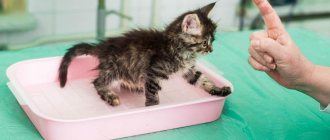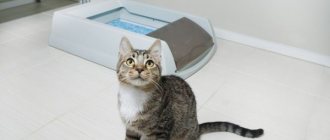A cat is an extremely clean animal. As experience shows, even a small kitten that has already been trained to go to the litter box will not just relieve itself in another place. If an owner regularly finds a smelly spot under the sofa, on the carpet or in a chair, he or she should think about the health of the pet or why this is happening.
You made a mistake during the learning process
You cannot force a kitten to go into the litter box. Any methods of punishing a kitten will be ineffective if the animal that has gone the wrong way is spanked, scolded, or poked with its muzzle into a puddle or pile. The innate quality of a cat is the desire to relieve itself in the same secluded place. Therefore, the process of training a kitten requires observation and a lot of patience. Harsh methods of coercion and punishment are unacceptable.
If the owner does this, the pet will choose a time, a place, hide and take revenge. Expert recommendations boil down to the fact that you should be especially attentive to the kitten after feeding, since the animal tends to go to the toilet after eating. At this time, you need to show him where the tray is located. Under no circumstances should you force him to sit in the tray, press on the sacrum, or dig for litter. With a patient, non-aggressive attitude, the kitten will definitely understand what is required of it.
The kitten does not go to the litter box - what to do, how to understand your pet
Each cat has its own character, and at the same time its own problems regarding the toilet. Some purrs categorically do not like a tray with any filler; they relieve themselves in an empty one. Others don't like trays with bars. Still others need two “toilets” - for big things and for small ones. You can find out all this only by carefully observing the kitten. And it’s better to take his habits into account and place two trays nearby than to regularly remove piles from the floor.
One of the main rules is that the tray must be clean. A kitten will not walk in a dirty place out of natural cleanliness. But what you definitely shouldn’t do is treat your cat’s litter with strong-smelling detergents. A strong chemical smell can scare your pet away. It is also not recommended to place the kitten's toilet in close proximity to the place where it eats. In general, the location of the tray must be taken responsibly. Choose a quiet, peaceful place where the kitten will have constant access. A closed door to the toilet or bathroom where the tray is located will force the baby to look for another corner for his needs.
It happens that a kitten does not want to sit in a tray that is in one corner of the toilet room, but immediately does its business in another corner. Take a closer look and listen, perhaps the baby doesn’t like that the tray is located close to the door or next to the toilet, and the kitten is scared by the noise of the flush cistern. Other household appliances can also frighten you: the roar of the refrigerator, the operation of the washing machine. It's best not to place a cat litter box next to them.
Sometimes the kitten categorically does not like the place chosen by the owner, for example, the bathroom. Instead, he chose the corridor. Try placing the tray there first, and then slowly move it closer and closer to the cherished goal.
The place for the tray is not secluded
For a cat, going to the toilet is a very important and intimate ritual. The tray must be placed in such a place that the kitten does not feel prying eyes when relieving itself. An animal sitting on a tray may be frightened by conversations, laughter, noise, or the curiosity of children or a dog. Therefore, the kitten’s latrine should be secluded and inaccessible to children and other animals. For this purpose, many people make a special hole in the toilet door or buy a closed toilet for cats. However, the easiest way is to explain to your household that you should not chase your cat when it goes to the toilet. You also need to teach the dog not to approach the kitten's litter box.
Bringing the kitten home
When the cub is separated from its mother and begins to live independently, it is taken to a new home.
Before you bring a kitten, you should first prepare everything:
- Buy a tray.
- Select and purchase filler.
- Buy a scoop for cleaning the tray.
- Choose a place for the toilet.
As soon as you bring the kitten into the house, place it in the litter box. To create the smell, you can take a napkin from the house where the kitten used to live, which was lying in the mother’s tray.
Show the kitten his toilet and let him get comfortable. The litter box must be in a secluded place so that the kitten feels comfortable and can do what he needs in silence and without distractions.
The next stage is to let the kitten get comfortable in the space. At the same time, he should not be frightened: nervous animals often have problems with training and adaptation. If the kitten gets scared, it may stop going to the litter box and it will be difficult to force it. The question of why a kitten doesn’t go to the toilet arises quite often, especially in the first months of its life in a new apartment.
In order for him to stop going to a place not intended for these purposes, you will have to make a little effort. In many ways, everything depends on the character of the pet and its intelligence, but occasionally there are cats that mark their territory. Usually this problem arises with the onset of puberty and there are other methods of solving it.
Perhaps the animal will learn on its own, but the owner will still have to help him and let him understand how to do it correctly.
Litter tray is not suitable for kitten
As you know, cats hide what they did after going to the toilet. However, if they don't like the filler, they can walk away from the tray. When a kitten has just been purchased, you need to check with the seller what kind of litter the animal is accustomed to. Some breeders use trays with bars, without filler. Others use silica gel, bentonite clay or sawdust. There are fillers with a strong aroma, which can also scare away the kitten. For cats, everything is individual. Only attention, patience and love will help the owner choose the best option for the pet.
The cat does not go to the toilet at all - reasons and solutions
Why does a cat refuse to walk small?
Have you noticed that the cat is recovering in its litter box, but there are no traces of urine, and have you sounded the alarm about this? They did the right thing, because small problems with refusal to go to the litter box can develop into big problems with urination.
Why doesn't a cat urinate:
- Inflammation of the bladder (cystitis);
Cystitis can begin both in cats walking outside and in those who spend their lives within four walls (if these walls are cold). Infectious infection is another cause of inflammation. Clinical tests help determine the diagnosis, and uroantiseptics and antibiotics help stop the disease.
- Inflammation of the urethra;
- Kidney diseases;
- Urinary tract obstruction (congenital or mechanical);
- Urolithiasis disease. If there are stones in the genitourinary tract, then urine excretion becomes impossible due to compression of the ducts.
If infections are excluded, the development of the disease is provoked by poor nutrition and a predominance of meat and fish in the diet.
All these conditions require immediate medical attention - take the animal to the veterinarian!
In a big way
If a cat doesn't poop, then it's probably not being mischievous. But he cannot do this because he suffers from constipation. There are several reasons for constipation:
- poor nutrition;
- stressful environment at home;
- disruptions in intestinal function.
In all cases, the cat needs your help. The easiest way is to feed the animal food that has a laxative effect: boiled beets, milk. In severe cases, only cat laxatives will help.
Important!
Constipation can be treated only after consulting a veterinarian and following his/her prescriptions.
The cat is going through puberty
Another reason why a kitten does not want to go to the litter box is the onset of puberty. It occurs between 6 and 12 months of age. At this time, you may find that the walls, furniture, clothing and other items in the house are splashed with your pet’s urine. Sometimes odor marks appear as large puddles throughout the house. Both male and female cats leave such signs. Therefore, if the owner does not plan to become a cat breeder, experts recommend spaying or neutering a young animal under the age of 1 year.
The kitten does not go to the litter box due to illness or stress - what to do
Refusal to use a litter box may tell the owner that something is not right with the kitten's health. If urination or defecation causes pain in your pet, he will instinctively strive away from the place with which these unpleasant sensations are associated.
Perhaps the cat has problems in the genitourinary area, for example cystitis, or is suffering from constipation; it is also possible to assume the presence of worms.
It's worth watching the kitten. If he goes to the toilet too often or too rarely, meows pitifully, or there is blood in the urine or feces, you should take the baby to the veterinarian.
A kitten trained to a litter box may refuse to use the usual toilet due to severe stress or fear. Apartment renovations, loud children's games, loud conversations, resentment towards the owner - all this affects the condition of the animals and can provoke behavior disorder. You need to be attentive to your pet and understand what he doesn’t like. Having eliminated the cause of concern, you can again accustom the kitten to the tray.
Kitten is stressed
Many cats react very nervously to any changes. They do not like moving, changing furniture, or repairs. They have a hard time with the arrival of new people in the house. For pets, having a baby can be stressful. In this case, you shouldn’t be surprised when puddles appear in unexpected places throughout the house. This only means that the kitten is stressed, he is marking his territory and defending himself. He should not be punished for this, but it is better to show him to the vet so that he can prescribe sedatives. This will help the cat recover and adapt to new living conditions.
- Author: Elena Romanenko
Rate this article:
- 5
- 4
- 3
- 2
- 1
(2 votes, average: 4.5 out of 5)
Share with your friends!
How to toilet train a kitten yourself
For a kitten, adapting to a new home and getting to know its owners can be very stressful.
Accustoming him to the necessary attributes of his daily life, such as a personal sleeping place, a bowl of food and water, and a toilet, will help him gain confidence and quickly settle into a new place. The question of how to toilet train a kitten is one of the most important. A timely completion of training to relieve oneself correctly guarantees that your pet will not develop bad habits in the future.
How to prepare a litter box for a kitten
First of all, you need to choose the right place where your pet will relieve itself. This should be a quiet and secluded corner where the washing machine does not make noise and the sewer pipe does not rattle. The cat's litter box should not be located too far away.
When he grows up, the toilet can be moved. It is important that the kitten gets accustomed to a certain place and filler (or lack thereof) in the tray.
How to toilet train a one month old kitten
Toilet training should begin when the kitten is 1 month old. At this time, kittens begin to consume complementary foods other than mother's milk. The tray can be placed next to the nest box so that the small kitten can run to it. By the age of 1.5-2 months, the kitten has already developed the corresponding reflex associated with visiting the litter box. Loose litter helps the kitten learn faster using the digging reflex.
A convenient situation is in which the mother cat had the opportunity to accustom the kitten to toilet procedures in the nursery. Visiting the litter box does not cause problems for such a kitten; you just need to add a little of the usual litter to his new litter box. If the kitten has no idea about the litter box, you need to worry about how to train the kitten to use the toilet at home yourself.
Stages of toilet training a kitten
Toilet training a one-month-old kitten usually does not cause problems and goes quickly enough. It is more convenient to start training kittens some time after feeding or sleeping, following these steps:
- Some time after feeding or sleeping, take the kitten to the toilet and watch him.
- When the kitten begins to give signals (crossing its paws, fussing, sitting down, sniffing, meowing), put it in the tray and do not let it out until it relieves itself.
- If the process is successfully completed, praise the kitten in a gentle tone and stroke it.
- In order for the kitten to be able to find his own place of toilet next time, you can dip a small napkin in the place where he defecates and leave it in the tray. After some time, the kitten itself will remember the algorithm of actions required of it.
- Toilet training should take place in a calm environment for the kitten. Even if the kitten has done something wrong, you should not scream, hit it or poke it with your nose. You need to use a dissatisfied tone to let the kitten know that he did the wrong thing, right at the moment of the mistake.
- The kitten may not like the filler. To eliminate this factor, you can try different filler textures and tray models.
- Helpers in toilet training can be special products that both attract cats and scare them away from unwanted places.
You can learn more about how to train a kitten to use the toilet in an apartment in the following video:
How to train a kitten to go to the toilet in a private house
Living in a private home, it may be more convenient for a cat to go to the toilet outside. Training a kitten to use the toilet outdoors begins with the usual litter box training scheme. After an adult kitten has learned to use the litter box, it should be moved closer and closer to the front door until it is behind it.
When the kitten sits down in the litter box, you should take him to a place where he can relieve himself outside of it. Over time, the need for a tray will cease to exist.
How to train a kitten to use the toilet in an apartment (in the toilet)
Many owners dream of getting rid of the responsibility of washing the tray and replacing the filler. However, a cat going to the toilet has many peculiarities. There is an opinion that this method is not completely natural and may interfere with the recognition of problems with the urinary system. Before toilet training, make sure that the kitten is old enough, accustomed to the litter box, has a tendency to learn quickly, and is not afraid of the toilet.
There are many ways to train a cat living in an apartment to use the toilet. The simplest method is to raise the tray level. Before you train your cat to use the toilet, you should make sure that it is old enough, accustomed to the litter box, and is not afraid of the sound of flushing water. The tray and toilet should be next to each other. Next, using stands or newspapers, you need to increase the level of the tray until it is equal to the level of the toilet.
The next step is to move the tray onto the toilet. The cat must learn to go to the litter box on the toilet. Then, you need to try to remove the tray. It is important to note that all rearrangements must be safe for the cat, and the tray must be well secured to prevent slipping. If your cat refuses to go to the toilet, you can try returning the tray to the toilet and trying again. You can try using special trays with an expanding hole.
Basic recommendations for toilet training a cat:
- Kittens can be toilet trained from 5 to 6 months of age.
- The toilet lid should not close or slam when the cat tries to clean up after itself.
- The entrance to the toilet must always be open.
- You can use special devices to train your cat to use the toilet.
- The toilet should be wiped with a cloth for hygiene purposes.
Toilet training a cat is considered an extremely difficult task for both owner and pet. Much more important is a calm state during the exercise of natural needs, and easy access to the toilet for your pet. By listening to the cat's behavior, you can understand whether this or that method of discharging its needs is convenient for it.
Difficulties that arise when toilet training a kitten:
- The kitten may not be comfortable getting into the litter box. The toilet should be proportionate for the kitten.
- Access to the toilet may be temporarily closed. Check whether it is easy for the kitten to open the door and get into the toilet.
- Are there any extraneous noises in the toilet: a running washing machine, humming pipes, objects falling from shelves, foreign chemical odors.
- The kitten may find the litter too large, hard, or smelly. You should experiment with different filler textures and try a different tray model.
- The tray may not be removed on time. For some cats, a dirty litter box may be a signal to look for another litter box.
- Before you toilet train your kitten, make sure that he is not under stress or illness. When cats have pain, they may go to relieve themselves in inappropriate places, expressing protest.
- If the kitten chose the wrong place as a toilet, wash away any traces of the crime and spray them with a special odor eliminator for animals.
- If you catch a kitten while relieving itself in the wrong place, you can lightly spray it with water and calmly express your dissatisfaction with words.
- Undesirable places chosen by the kitten as a toilet can be blocked by rearranging the furniture or closing the door there.
- At first, you can place trays in several places, allowing the cat to choose the most convenient one.
- The reason for going to the wrong place may be illness or discomfort. The cat is trying to find a place where it does not feel pain. In this case, she should be immediately shown to a veterinarian.
- A cat may protest against any changes or your actions by using the toilet in the wrong place. It is important to find out the cause of her anxiety and establish contact with the pet.
By showing patience and perseverance when toilet training a kitten, you will teach it to be well-mannered for the rest of its life, and communicating with your pet will only bring joy.
Tray selection
Which tray should you choose for a kitten? This can be any container that has a suitable shape and size. The height of the tray is selected according to the height of the kitten and the filler used. If the tray is not high enough, the entire floor will be covered with scattered filler. If you decide that your pet will use a tray without filler, then make sure to equip it with a grid. Who would like to stand with their paws in a puddle!
Tray with grid
You can use it as cat litter
- sand,
- pressed sawdust,
- cut paper,
- special absorbent filler.
The main thing is that the kitten likes the filler you choose. Otherwise, he may refuse to use it for its intended purpose.
Deep tray
By the way, a cat does not always refuse the tray due to simple reluctance or whim. This behavior can be caused by completely different things. It may be not only the filler, but also the size of the tray, which may not be deep enough or small. The reason may be hidden in the fresheners that are used to treat the toilet, but are not to your pet’s taste. An ultra-clean cat may refuse a tray with litter that has not been changed for a long time. Some cats even have to have two litter boxes at once, since these finicky creatures will not go to the same litter box twice.
Is it possible to train a kitten to use the toilet?
Some cats can also become toilet trained. Some pets willingly agree to this.
It is quite easy to train a cat to use the toilet. This needs to be done, as they say, “from a young age.” First, the kitten must get used to using a regular tray, which is placed next to the toilet. Then, gradually, place something under the tray until it reaches the same level as the toilet. After this, the tray is removed and the kitten only has to understand what, in fact, is required of it. As a rule, the majority understands quite quickly what to do. However, if the kitten has been using the litter box for a long time, there is no need to retrain it.
Cat on the toilet
Hygiene
Never forget to empty the litter box. This needs to be done at least daily. For such a clean animal as a cat, it is very important that the tray is clean, and she does not have to look for a corner in order to relieve herself. Every week the tray must be washed using soap products used to maintain cleanliness in the premises. Detergents must be thoroughly rinsed from the surface of the tray to remove their odor.
One more rule must be followed - in your house, each cat should have a litter box plus one more.
Thus, for two cats you need to purchase three trays. Moreover, if you live in a two-story house, then on each floor there should be a toilet for cats. If a cat is trained to use a litter box and always has free access to it, it will never shit anywhere.
cat litter
Adviсe
You should not use scented cat litter. Many cats prefer not to use this type of litter box. And rightly so. Because owners choose flavored fillers for themselves, and not for their pets, who do not like such fillers with a strong fragrance. It is better to use natural fillers (the same sand, sawdust, etc.).
The tray should be chosen to match the size of your pet. Large breeds of cats - Maine Coon, Ragdoll, Siberian, Bengal - require the installation of large trays for the convenience of the animals discharging their needs. Smaller breeds can get by with smaller trays. Choosing the right size will help your kitten toilet train faster.
Maine Coon
An important role in toilet training a kitten belongs to the place where the tray is located. Often the tray is placed in the bathroom or toilet. In this case, you need to make sure that the kitten can always use it. To ensure constant access, the doors to these rooms should remain slightly open, or you can equip them with a special hole for the pet. You should not place the tray where the kitten's food and water are.
If you also have a dog at home, then the cat tray should be placed in a place inaccessible to the dog. A place near loud operating equipment is also not suitable for a cat litter box, since the cat may be frightened by loud noise. By following these simple rules, you can create comfortable conditions for your pet and ensure comfort and peace for yourself. After all, every owner likes it when the cat goes to the toilet in the right place. We hope that our tips will help you achieve the desired result faster and more efficiently.
note
Rarely, but still there are cases when a kitten cannot be trained to its proper place. In this case, you can strictly talk to the kitten, but under no circumstances should you physically punish it. This will not be of any use to the cause. Take the kitten to the litter box again and again and try to “persuad” him to use the toilet. You should be persistent and unyielding in achieving your goals, but you just need to not be nervous and act kindly. The area where the kitten has soiled must be thoroughly washed and even disinfected to eliminate the smell that attracts the kitten to the scene of the “crime.”
Bengal
It must be borne in mind that most cats are well versed in the peculiarities of the rules that are accepted in the house, and the problem of the toilet can be used to influence the owner. Moreover, some want to attract more attention to themselves, others may take revenge for the punishments that took place. But this could simply be a ritual of marking territory during the mating season, as well as evidence that the cat has serious health problems. By observing the cat in each individual case, you can discover the reason for this behavior of the animal.











